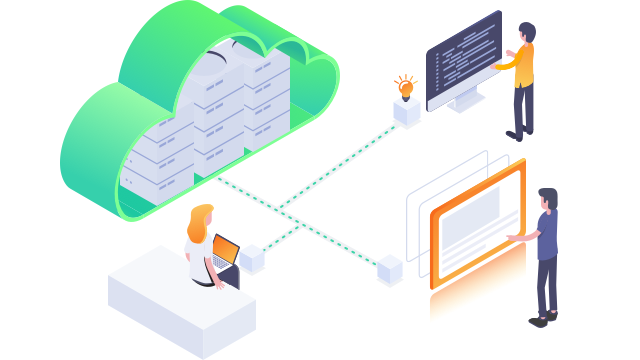AI Cloud Instance
Our cloud service makes it easy to deploy container-based GPU instances in seconds, from either public or private repositories. This means that you can get started with GPU computing quickly and easily, without having to worry about managing your own hardware.

SEALMINER
Bitdeer autodesarrolladas máquinas de minería aprovechan el avanzado chip serie SEAL para lograr una eficiencia excepcional, con una arquitectura de diseño totalmente nueva que maximiza el potencial del chip, garantizando fiabilidad, durabilidad y un rendimiento óptimo incluso en entornos duros.

Recursos
Navegue por nuestro centro de recursos para encontrar lo que necesita. Suscríbase para mantenerse al día de nuestras últimas noticias, anuncios y publicaciones del blog.
Suscríbase a nuestro boletín

Cryptocurrency Profile – Bitcoin (BTC)
11.03.2023
Unlike common fiat currencies issued by institutions, Bitcoin is created by solving complex mathematical problems.
What is Bitcoin? Bitcoin (BTC) is a ‘peer-to-peer’ cryptocurrency. Unlike common fiat currencies issued by institutions, Bitcoin is created by solving complex mathematical problems. It is possible to send and receive decentralized Bitcoin anywhere in the world at any time. As the total Bitcoin supply will never exceed 21 million, some believe it to be a global safe-haven asset.
Principles of Bitcoin
In the Bitcoin system, money is not sent like the digital transfer of cash in fiat currency transactions. Assume there are four people known as A, B, C, and D. A transfers ten Bitcoin to B, B transfers five Bitcoin to C, and C transfers two Bitcoin to D. With traditional currencies, these transactions are recorded in the banking system and users only need to keep an eye on their balances. As for Bitcoin, all users share a single ledger that records all transactions, and this ‘synchronized’ ledger is visible to all users. The ledger is actually just the blockchain database, within which no transaction data can be tampered with. When there is a transaction, the relevant information is broadcast directly to the peer-to-peer network and then recorded in this database by miners through their mining activity.
How is Bitcoin mined?
Mining is the process of working out the required ‘hash’ (numeric) value through a series of algorithms. The miner that first calculates the correct value can pack the Bitcoin transactions into a block and record it on the blockchain to get the corresponding Bitcoin as a reward. The mining process involves the purchase of a rig, as well as logistics and transportation, mining site selection, rig operation and maintenance, and mining pool access. You can also mine Bitcoin easily through Bitdeer's computing power-sharing services. By purchasing a mining plan, you can earn everyday based on the coin price and the entire network's computing power.
Bitcoin’s Inception
On October 31, 2008, Satoshi Nakamoto published the Bitcoin whitepaper—"Bitcoin: A Peer-to-Peer Electronic Cash System” on the Cryptography Mailing List in which he introduced Bitcoin to the world.
On January 3, 2009, Satoshi Nakamoto developed the first Bitcoin software and mined the first Bitcoin block—the Genesis Block—on a small server in Helsinki, Finland with a reward of 50BTC.
In 2010, Satoshi Nakamoto, whose true identity remains a secret, mysteriously disappeared. NonetelessBitcoin went on to become as well-known as it is today.
Bitcoin Value
- Payment. Bitcoin can be used as a currency to purchase goods or services directly. Many websites and merchants already accept Bitcoin.
- International remittance. Decentralized, secure, and borderless Bitcoin is often used for international remittances. It is an effective way to save time, effort, and money, and protect individual identity.
- Investment. The 21-million-coin limit makes Bitcoin scarce and has earned it the name "digital gold." Some investors use it as a short-term investment vehicle but there are many long-term holders (or ‘hodlers’ as Bitcoin fans call them) as well. Plus, the Bitcoin price has hit record highs many times.
Milestones
October 31, 2008: Satoshi Nakamoto releases the Bitcoin whitepaper—"Bitcoin: A Peer-to-Peer Electronic Cash System.
January 3, 2009: the Genesis block of Bitcoin is created.
May 21, 2010: Laszlo Hanyecz, a programmer in Florida, buys two pizzas using 10,000 Bitcoin. It is the first time that Bitcoin is used as a currency. That day has become known as "Bitcoin Pizza Day."
November 28, 2012: the first Bitcoin ‘halving’ takes place, reducing the reward for mining a block from 50BTC to 25BTC.
October 1, 2013: the FBI arrests the founder of the Silk Road website, Ross William Ulbricht, at the San Francisco Public Library, seizing nearly 30,000 Bitcoin held by Silk Road and 144,000 Bitcoin held by Ulbricht himself.
October 29, 2013: Robocoin and Bitcoiniacs launched the world's first Bitcoin ATM in Vancouver. Users could now transfer money via a Bitcoin ATM near them.
August 1, 2017: Bitcoin hard-forks after years of scaling debate. Segwit proponents have been supporting Bitcoin continuously, while those supporting Big Block created Bitcoin Cash (BCH). Every user holding a Bitcoin token is airdropped a Bitcoin Cash token.
May 12, 2020: the Bitcoin blockchain underwent its third halving, reducing the mining reward from 12.5BTC to 6.25BTC.
Answer the following questions to test your Bitcoin knowledge
- How many Bitcoins are there?
- What is Bitcoin’s consensus algorithm?
- Who created Bitcoin?
*Information provided in this article is for general information and reference only and does not constitute nor is intended to be construed as any advertisement, professional advice, offer, solicitation, or recommendation to deal in any product. No guarantee, representation, warranty or undertaking, express or implied, is made as to the fairness, accuracy, timeliness, completeness or correctness of any information, or the future returns, performance or outcome of any product. Bitdeer expressly excludes any and all liability (to the extent permitted by applicable law) in respect of the information provided in this article, and in no event shall Bitdeer be liable to any person for any losses incurred or damages suffered as a result of any reliance on any information in this article.







